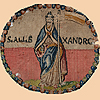 |

1739
Antique Italian Wool Tapestry of Staint Alessandro
7th Century
Size 12" x 11"
Size 31 x 28cm
More Information Below
Alexander of Bergamo (died c. 303) is the patron saint of Bergamo as well as Capriate San Gervasio and Cervignano d’Adda. Alexander may have been a Roman soldier or resident of Bergamo who was tortured and killed for not renouncing his Christian faith. Details of his life are uncertain, but subsequent Christian stories consider him a centurion of the Theban Legion Legion commanded by Maurice.
Italian Textile History
|
 Antique Tapestry of Staint Alessandro
Antique Tapestry of Staint Alessandro

Saint Alessandro
Alessandro, the patron saint of the city of Bergamo, is traditionally depicted as a Roman soldier with a banner bearing a white lily. The banner would be that of the Theban Legion commanded by s. Maurizio (Roman legion composed according to legend, by Egyptian soldiers of the Thebaid) in which Alexander would have been according to the Acts of martyrdom, commander centuria. The Roman legion used mainly in the East, was moved to 301 West to controbbattere attacks Quadi and Marcomanni. During the crossing of the Valais to the legion was ordered to seek Christians against whom had been unleashed a persecution. The legionaries, Christians in turn, refused and for this insubordination were punished with the decimation performed at Agaunum (now St. Moritz). Decimation consisted in the killing of a man every ten. The continuing refusal of the legionaries to persecute the Christians, was performed a second decimation and then the emperor ordered the extermination. Few were the survivors, including Alessandro, Cassio, Severino, Second and Licinio who fled to Italy. In Milan Alessandro, however, was recognized and imprisoned, where rifuta to recant. In prison, he is visited by s. Faithful and the bishop s. Maternal. S own. Fedele manages to organize the escape of Alexander, which shelters in Como, where he was captured again. Brought back to Milan was sentenced to death by beheading, but while running the Executioner stiffened arms. It was then re-arrested. He managed to escape again and reached via Bergamo Fara Gera d'Adda and trusses. In Bergamo was hosted by Prince Crotacio, who invited him to hide, but Alessandro began to preach and convert many of Bergamo, including the martyrs Fermo and Rustico. It was thus discovered and captured again, decapitation was performed publicly August 26 303 in the place where today stands the church of St. Alexander in Column. Probably Alexander was actually a Roman soldier, a native or resident in Bergamo, tortured and killed for not having renounced their Christian faith. |
 |
|
|
|
|















